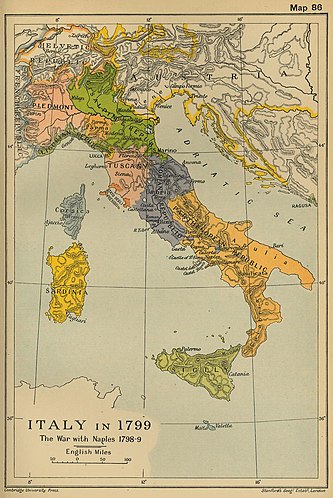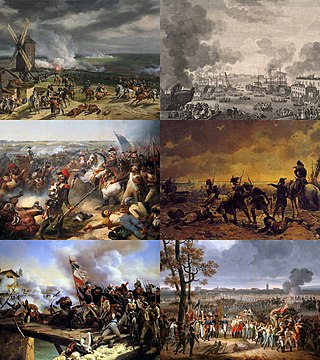
The War of the First Coalition was a set of wars that several European powers fought between 1792 and 1797 initially against the constitutional Kingdom of France and then the French Republic that succeeded it. They were only loosely allied and fought without much apparent coordination or agreement; each power had its eye on a different part of France it wanted to appropriate after a French defeat, which never occurred.

The French Revolutionary Wars were a series of sweeping military conflicts lasting from 1792 until 1802 and resulting from the French Revolution. They pitted France against Britain, Austria, Prussia, Russia, and several other monarchies. They are divided in two periods: the War of the First Coalition (1792–1797) and the War of the Second Coalition (1798–1802). Initially confined to Europe, the fighting gradually assumed a global dimension. After a decade of constant warfare and aggressive diplomacy, France had conquered territories in the Italian Peninsula, the Low Countries and the Rhineland in Europe and abandoned Louisiana in North America. French success in these conflicts ensured the spread of revolutionary principles over much of Europe.

The Napoleonic era is a period in the history of France and Europe. It is generally classified as including the fourth and final stage of the French Revolution, the first being the National Assembly, the second being the Legislative Assembly, and the third being the Directory. The Napoleonic era begins roughly with Napoleon Bonaparte's coup d'état, overthrowing the Directory, establishing the French Consulate, and ends during the Hundred Days and his defeat at the Battle of Waterloo. The Congress of Vienna soon set out to restore Europe to pre-French Revolution days. Napoleon brought political stability to a land torn by revolution and war. He made peace with the Roman Catholic Church and reversed the most radical religious policies of the Convention. In 1804 Napoleon promulgated the Civil Code, a revised body of civil law, which also helped stabilize French society. The Civil Code affirmed the political and legal equality of all adult men and established a merit-based society in which individuals advanced in education and employment because of talent rather than birth or social standing. The Civil Code confirmed many of the moderate revolutionary policies of the National Assembly but retracted measures passed by the more radical Convention. The code restored patriarchal authority in the family, for example, by making women and children subservient to male heads of households.

The War of the Second Coalition was the second war on revolutionary France by most of the European monarchies, led by Britain, Austria, and Russia, and including the Ottoman Empire, Portugal, Naples, and various German monarchies. Prussia did not join this coalition, and Spain supported France.

The history of Italy from 1559 to 1814 was characterized by the domination of foreign nations over Italy, and corresponds to the period that began in 1559 with the end of the Italian Wars and ended in 1814 with the fall of Napoleon. The following period was characterized by political and social unrest which then led to the unification of Italy, which culminated in 1861 with the proclamation of the Kingdom of Italy.

The papal conclave that followed the death of Pius VI on 29 August 1799 lasted from 30 November 1799 to 14 March 1800 and led to the selection of Cardinal Barnaba Chiaramonti, who took the name Pius VII. This conclave was held in Venice and was the last to take place outside Rome. This period was marked by uncertainty for the papacy and the Roman Catholic Church following the invasion of the Papal States and abduction of Pius VI under the French Directory.

The Italian campaigns of the French Revolutionary Wars (1792–1802) were a series of conflicts fought principally in Northern Italy between the French Revolutionary Army and a Coalition of Austria, Russia, Piedmont-Sardinia, and a number of other Italian states.

A sister republic was a republic established by French armies or by local revolutionaries and assisted by the First French Republic during the French Revolutionary Wars. These republics, though nominally independent, relied heavily on France for protection, making them more akin to autonomous territories rather than independent states. This became particularly evident after the declaration of the French Empire, when several states were annexed, and the remaining turned into monarchies ruled by members of the Bonaparte family.
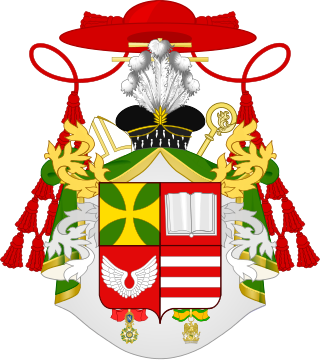
Giovanni Battista Caprara Montecuccoli was an Italian statesman and Cardinal and archbishop of Milan from 1802 to 1810. As a papal diplomat he served in the embassies in Cologne, Lausanne, and Vienna. As Legate of Pius VII in France, he implemented the Concordat of 1801, and negotiated with the Emperor Napoleon over the matter of appointments to the restored hierarchy in France. He crowned Napoleon as King of Italy in Milan in 1805.
The Treaty of Tolentino was a peace treaty between Revolutionary France and the Papal States, signed on 19 February 1797 and imposing terms of surrender on the Papal side. The signatories for France were the French Directory's Ambassador to the Holy See, François Cacault, and the rising General Napoleon Bonaparte and opposite them four representatives of Pius VI's Curia.

The Army of Italy was a field army of the French Army stationed on the Italian border and used for operations in Italy itself. Though it existed in some form in the 16th century through to the present, it is best known for its role during the French Revolutionary Wars and Napoleonic Wars.

The First French Empire, officially the French Republic, then the French Empire after 1809, also known as Napoleonic France, was the empire ruled by Napoleon Bonaparte, who established French hegemony over much of continental Europe at the beginning of the 19th century. It lasted from 18 May 1804 to 3 May 1814 and again briefly from 20 March 1815 to 7 July 1815.

Michelangelo Alessandro Colli-Marchi, or Michele Angelo Alessandro Colli-Marchei or Michael Colli, joined the Austrian army, became a general officer, and led the army of the Kingdom of Sardinia-Piedmont for three years, including its unsuccessful campaign against Napoleon Bonaparte in 1796. In early 1797, he was given command of the army of the Papal States, but was defeated at Faenza.
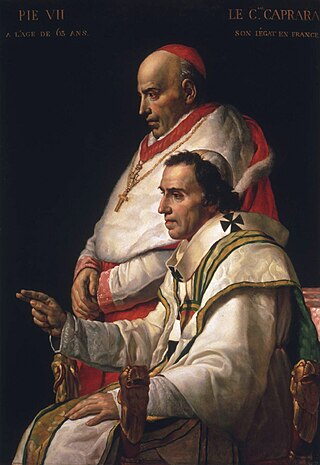
The relationship between Napoleon and the Catholic Church was an important aspect of his rule.
The modern history of the papacy is shaped by the two largest dispossessions of papal property in its history, stemming from the French Revolution and its spread to Europe, including Italy.

The Battle of Faenza, also known as the Battle of Castel Bolognese on February 3, 1797 saw a 7,000 troops from the Papal Army commanded by Michelangelo Alessandro Colli-Marchi facing 9,000 troops from the French Army under the command of Claude Victor-Perrin. The veteran French troops quickly overran the Papal army, inflicting disproportionate casualties. The town of Castel Bolognese was located on the banks of the Senio River 40 kilometres (25 mi) southeast of Bologna, and the city of Faenza was also nearby. The action took place during the War of the First Coalition, as part of the French Revolutionary Wars.
Liborio Angelucci was an Italian physician and politician.

The Piedmontese Republic was a revolutionary, provisional and internationally unrecognized government established in Turin between 1798 and 1799 on the territory of Piedmont during its military rule by the French First Republic.
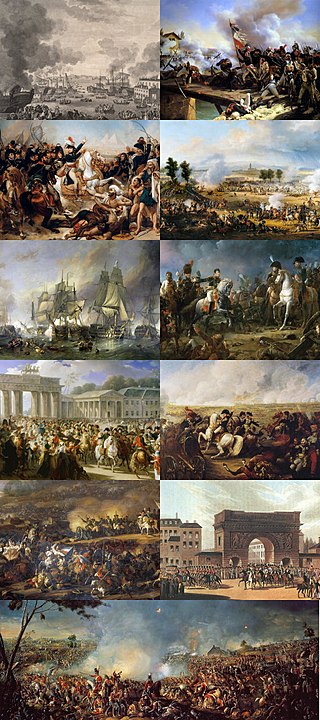
The French Revolutionary and Napoleonic Wars, sometimes called the Great French War, were a series of conflicts between the French and several European monarchies between 1792 and 1815. They encompass first the French Revolutionary Wars against the newly declared French Republic and from 1803 onwards the Napoleonic Wars against First Consul and later Emperor Napoleon Bonaparte. They include the Coalition Wars as a subset: seven wars waged by various military alliances of great European powers, known as Coalitions, against Revolutionary France – later the First French Empire – and its allies between 1792 and 1815:
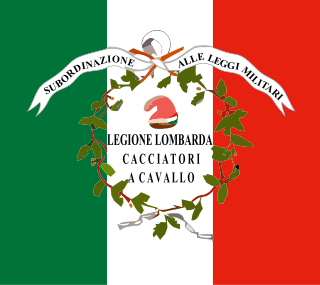
The Lombard Legion was a military unit of the Cisalpine Republic which existed from 1796 until the Republic's fall in 1799. The Lombard Legion was the first Italian military department to equip itself, as a banner, with an Italian tricolor flag.




